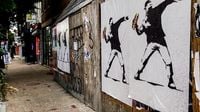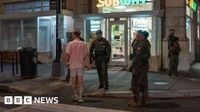On a humid August night in Washington, D.C., a submarine sandwich became an unlikely symbol of protest, landing its thrower, Sean Charles Dunn, in the eye of a legal and political storm. This week, a jury is deliberating Dunn’s fate in a misdemeanor assault case that has drawn national attention, not just for its unusual details but for the broader tensions it reflects at the intersection of political dissent, law enforcement, and public spectacle.
The incident unfolded on August 10, 2025, when Dunn—then a Justice Department employee—approached a group of U.S. Customs and Border Protection (CBP) agents stationed outside a nightclub hosting “Latin Night” in the U Street Corridor, a bustling nightlife district. According to charging documents and eyewitness accounts reported by BBC and The New York Times, Dunn confronted the agents, calling them “fascists” and “racists,” and chanting “shame” at them. The scene, already tense, escalated as Dunn shouted, “Why are you here? I don’t want you in my city!” before hurling a salami sub at point-blank range at CBP Agent Gregory Lairmore.
The sandwich, as Agent Lairmore later testified, “exploded all over him,” leaving a visible mustard stain and even an onion string hanging from his police radio. “I could feel it through my ballistic vest,” Lairmore told the jury, recalling the impact and the unmistakable scent of onions and mustard that lingered on his uniform. The moment was caught on video and quickly went viral, ricocheting across social media and transforming Dunn into a folk hero for some D.C. residents who opposed President Donald Trump’s deployment of federal agents and National Guard troops to the city that summer.
Dunn didn’t deny his actions. In fact, body camera footage played in court captured him telling officers after his arrest, “I did it. I threw a sandwich. I did it to draw them away from where they were. I succeeded.” But while the facts of the sandwich toss are not in dispute, the legal and political implications have become fiercely contested. Prosecutors from U.S. Attorney Jeanine Pirro’s office initially sought felony assault charges, but a grand jury refused to indict Dunn on those grounds—a rare rebuke that forced prosecutors to pursue a lesser misdemeanor charge instead.
The trial, which began with jury selection on November 3, 2025, has been marked by procedural drama. U.S. District Judge Carl Nichols employed a white noise machine to prevent the public and media from hearing questions posed to potential jurors, a move Dunn’s attorneys argued violated his right to a public trial. Their motion to restart jury selection was denied by the judge, who deemed such a step “drastic.” Opening statements followed the next day, with both sides staking out sharply opposing narratives.
On one side, prosecutors insisted that Dunn’s actions constituted a clear violation of the law. “This is not a case about someone with strong opinions,” Assistant U.S. Attorney Michael DiLorenzo told jurors. “It’s about an individual who crossed the line.” Prosecutor John Parron, as quoted by The New York Times, added, “No matter who you are, you can’t just go around throwing stuff at people because you’re mad.” The government’s position was bolstered by video evidence showing Dunn’s sandwich throw at close range and his shouted obscenities at the officers.
On the other side, Dunn’s defense team, led by attorneys Sabrina Shroff and Julia Gatto, argued that the case was an example of selective and vindictive prosecution. “A footlong from Subway could not and certainly did not inflict any bodily harm,” Shroff told the jury during closing arguments. “Throwing a sandwich is not a forcible offense.” Gatto echoed this sentiment, calling the toss a “harmless gesture that did not, could not, cause injury.” The defense also questioned the seriousness of the alleged assault, noting that Agent Lairmore’s colleagues later gave him gifts poking fun at the incident, including a sandwich-shaped plush toy and a “felony footlong” patch for his lunchbox. “If someone assaulted you, someone offended you, would you keep mementos of that assault?” Shroff asked jurors. “Of course not.”
Dunn’s lawyers further contended that he was targeted not for the nature of his actions, but for his outspoken, viral critique of the administration’s policing and immigration policies. They pointed to Attorney General Pam Bondi’s social media post announcing Dunn’s firing from the Justice Department—where he had worked as an international affairs specialist—and the White House’s decision to post a highly produced video of the armed raid on Dunn’s home as evidence of a politically motivated prosecution.
The sandwich-throwing episode quickly became part of Washington’s cultural lexicon. “Sandwich guy” stickers, murals, and even Halloween costumes began appearing across the city, as residents rallied against what many saw as the overreach of federal law enforcement. The deployment of National Guard troops and CBP agents to D.C. that summer, ostensibly to “crack down on crime,” was met with outrage by locals who viewed it as the politicization of the military and an affront to the city’s autonomy.
The case has also drawn attention to broader questions of consistency in the application of justice. As AP News reported, dozens of Trump supporters who stormed the Capitol on January 6, 2021, were convicted of felonies for assaulting or interfering with police, only to be pardoned or have their charges dismissed by Trump himself. Dunn’s defense team has argued that the government’s pursuit of his case, in contrast, underscores the selective nature of the prosecution.
For now, the jury must decide whether Dunn’s sandwich toss amounts to a criminal assault or a symbolic act of protest blown out of proportion by political forces. Dunn did not testify at his trial, but his motivations and the context of his actions have become central to the case. Whether the jury sees him as a lawbreaker or a protester making a statement remains to be seen.
Whatever the verdict, the “sandwich guy” saga has become a telling snapshot of a city—and a nation—grappling with the boundaries of protest, the reach of law enforcement, and the power of viral moments to shape public debate.






